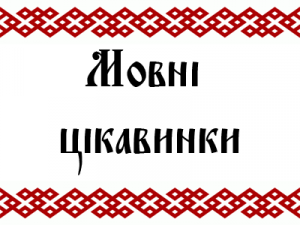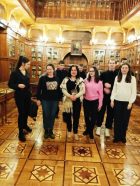When teaching students the course “History of Ukrainian Culture” special attention should be paid to highlighting questions about the phenomenon of Ukrainian mentality and especially the formation of the mentality of the Ukrainian people. According to the educational work program is subject is discussed in the first lecture is one of the key for further study and understanding of the students of this course.
First of all, students should remind interpretation of concepts: the mentality, mentality, national mentality, mental field, outlook, universal, phenomenon like. (See. Great Dictionary of Modern Ukrainian movy.- K. Perun, 2007, s.659). The term originated in history, but its use was common in sociology and psychology. In fact, the concept of mentality is quite large and encompasses many aspects specific to a particular person or social group.
The concept of mentality, introduced in the scientific revolution in the early twentieth century French scientist L.Levi brulee. There is no clear terminological definition of the term, do not create practical tools for its study. Because there are many interpretations, which explain the essence of this phenomenal phenomenon.
In modern science, the cultural historical and cultural process is seen as being of different types, forms and types of mentality (historical – ancient, medieval …; civilizations – Chinese, Slavic …; age – children, teenagers, etc. …). And also – political, social class, caste, group, regional, human values, national, etc., according to the principles and objectives of the study. In scientific studies are determining mentality that has or is unrelated to the so-called “universal values” – a cosmopolitan, international, civilized, nationalist, racist.
National mentality – is inherent in this ethnic community lifestyle, culture and peculiar to this nation’s values, beliefs, world rice character, behavior, psychological characteristics of the individual. Among these factors of particular importance to highlight the issue of the curriculum becomes culture because the culture is the phenomenon of ethnically rooted so deeply and national. National mentality causes, recognizes the features of the soul, heart and mind, is the core of what is called the character of the people and that largely makes people Ukrainian, Belarusians, Russians, Germans, Turks, Poles, Japanese and others.
Later research mentality has become a self-direction philosophy, sociology, cultural studies, history, linguistics and other sciences.
In considering the “phenomenon of Ukrainian mentality, worldview universals Ukrainian nation”, students’ attention should be paid to the history of the formation of the mentality of modern East nations and states. It is advisable to recall that modern Slavic states are descendants of Eastern tribes.
East Slavic tribes – the group of Slavic tribes, located on the territory of Ukraine and Belarus, whose ancestors were anti Dulebs and (Volynyane), they lived on the territory between the Carpathians, Pripyat and the Middle Dnieper.
It is also necessary to pay attention to students ethnogenesis Eastern nations (ie, the process of creating ethnic group) is complex and controversial. Among scientists there is no consensus. There are a number of concepts ethnogeny East nations. There are several fundamentally different concepts ethnogenesis. These concepts singled out the concept of ancient peoples, based on fabricated facts.
Concept of ancient peoples as the cradle of three fraternal peoples formulated rather late – after the Second World War.
In the scientific and journalistic literature has repeatedly violated the theme of the origin and anthropological distinctions Ukrainian, Russian and Belarusian. It is necessary to clearly define milestones and modern history of racial differences in physical type of these ethnic groups. Many speak of the relationship of the Slavic people, the unity of Ukraine, Belarus and Russia. But Russia, in our opinion, should be excluded from this list, since Ukrainian and Russian belong to different anthropological complexes. Thus, the Ukrainian naysporidnenishymy are Belarusians, Poles and Baltic nations that belong to a common large complex biological traits.
Mentality – a prism through which a person looks at the world and ourselves in it. So we can say that it is inherent in every person, regardless of ethnicity, social status, gender, language and so on. Of course, the mentality depends on these factors, particularly the nationality and caused her language and culture, but they do not deny its existence, but rather form a mentality.
Analyzing the history of the formation and the formation of mentality Eastern nations and states, we can see that the characteristics of the mentality of Ukrainian, Russian and Belarusian different.
Although for centuries these people have many common interests, neighboring territory similarity origin, language, religion, etc., however, the historical development of different, which significantly affected their mentality and formation of national values.
In our view, the students in the independent study on the above topics advisable to offer: 1.Provesty classroom discussion on “Your observation about the difference in the mindset
Ukrainian, Russian and Belarusian” or “Is Ukrainian brothers, Russians and Belarusians?” (See. References).
- Pidhotuvatysya zasidnni to participate in the “round table” (or Internet conferences) on “12 myths about Ukrainian language”, using research scientists – cond. Institute of Ukrainian National Academy of Sciences, prof. Hrycyuk prof.Masenko L., I. dots..Farion
- Lay the table “Comparative characteristics mentality Eastern nations and peoples of Europe.” The table must have the nationality, race, kind of mentality, climatic factors, geopolitical factors, archetypes, attitudinal characteristics, common and distinctive features, morality and behavior, values, intellectual, emotional, linguistic and cultural differences, positive and negative traits mentality and so on. (See. References);
Cultural, social and psychological study of the phenomenon Ukrainian mentality it can determine the following essential elements:
anteyizm (a term derived from the character of Greek mythology, which gave vitality contact with Mother Earth) – emotional and respect for the earth, mother nature, agriculture, which found practical expression in performance, achievements of agriculture Ukrainian people; kordotsentrychnist (feel the heart) – is in sentimentalism, sensitivity, love of nature, folk songs, colorful obryadnosti, aesthetic life; ekzystentsialno- “boundary” attitude – long stay at the “limits” hostile desert produced in Ukrainian hostroemotsiyne sohodennosti life experiences, the priority of the past over the future, ideological and pluralistic vision of the world in the dialog poetyzovanoyu communion with nature, the human environment. Combined with kordotsentrychnistyu (priority “heart” of the “head”) is the ideological orientation of Ukrainian-ekzystentsionalno kordotsentrychnymy; individualism – is in various forms aspirations for personal freedom without proper aspiration for statehood. Individualistic code values inherent Ukrainian people, autonomy stimulates motivation, needs to rely on their own strength, requires equality and does not involve violence. However, going beyond individualism may turn to anarchism. Worldview explains the motivation equality Ukrainian tolerance for other people’s faith, language and customs.
The formation of the Ukrainian mentality significantly affects geographically geographical location of Ukraine for borderlands “Europe and Asia” that the historical and cultural dimension of philosophical meaning between “East and West”. For a long time Ukrainian people realized its world-historical mission as a buffer between the two types of civilization – Western, European and Eastern, Muslim. This situation in all historical times contributed to the fact that people endured their ideals beyond real experience. It is characteristic of Ukrainian religion, which is not ritual tradition and the call of the soul. “Boundary” situation formed the Ukrainian mentality are two types: agricultural (combination of his land, his family, “the world – this is my house”) and Cossack – knightly and warlike spirit and military ideals of brotherhood, eternal journey. This determines the particular role of women in the Ukrainian mentality, its independence precedence over men in everyday life, rituals, customs, mythology and demonology, in folklore.
At the present stage of our society mentality continues to play its important role as a “built into the society” regulator of economic, political and cultural events.
Briefly summarizing, it should be noted that even long Ukrainian and Russian nations develop in different ways, which is reflected both in our mutual understanding, and the newly established traditions and values over the last 25 years and. If the twentieth century Ukraine could still called “Little Russia” znuschuvaty and its people, but today it is a separate and independent state, which has its own people as an ethnic Ukrainian and Ukrainian political nation. The common history does not mean that we are the same. It was an artificial story. Now we are different.
References:
1.Ohiyenko I. History of Ukrainian literary language. – K .: Our culture and science, 2001. – 440 p.
2. Bychko AK etc .. The theory and history of world and national culture: Lectures. K .: Lybed, 1992 – 392 p.
3.12 myths about Ukrainian language. Rezh.dostupu: http://www.volfoto.inf.ua/pagesi/istomist/statti/2012rik/dm120621/t120627/mova/mova.htm.
4. Smityuh GE, Shooting V. Ukraine sacral; past, present, maybutnye.- Kyiv, Ukraine Knowledge, 2006. – 36 p. Bibliographic description of the paper version of the publication. Dir. Access: http://www.myslenedrevo.com.ua/uk/Publ/SacralUkraine.html
5. A. Strazhnyy Ukrainian mentality. Illusions – myths – reality. – K .: “Book”, 2009. 368 p.
6. Kirienko VV Belarusian mentality: Origins, Present and Prospects / B. Kiriyenko. – Gomel: HHTU them. PO Sukhoi, 2009. – 319s.
7. Kostomarov N. RED // n nationality basis. – SPb., 1861. – №3, s.33-8 8. Melnikov AP National Belarusian mentality. – Mn .: IOOO “Law and Economics”, 2004. – 78S.
9. Lartsev VS .: Formation of Ukrainian identity, spiritual and mental factors in the context of the present. Rezh.dostupu: http://www.iai.dn.ua/_u/iai/dtp/CONF/10/articles/sec1/s1a1 10. Theory /Vidpov.red mentality. Popovich MV /. -K., Scientific Thought, 2006. – 404 p. 11. Fedorov II Cultural: Navch.posib. – K .: Izd “Polytechnic”, 2005. – 160 p. 12.Fenomen Ukrainian culture: methodological principles of understanding/ ed. V.Shynkaruka. = C .: Phoenix, 1996. – 476 p.







